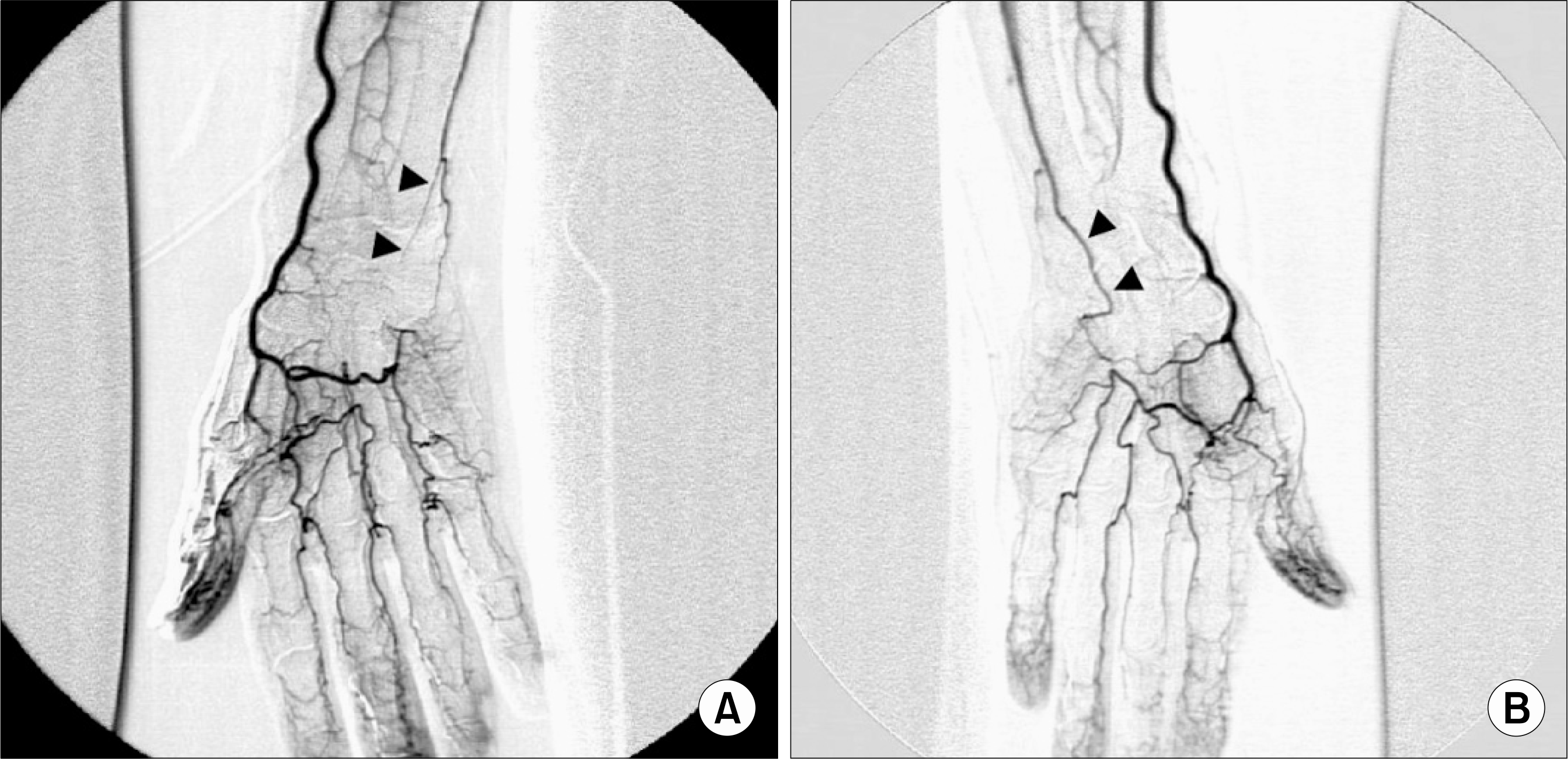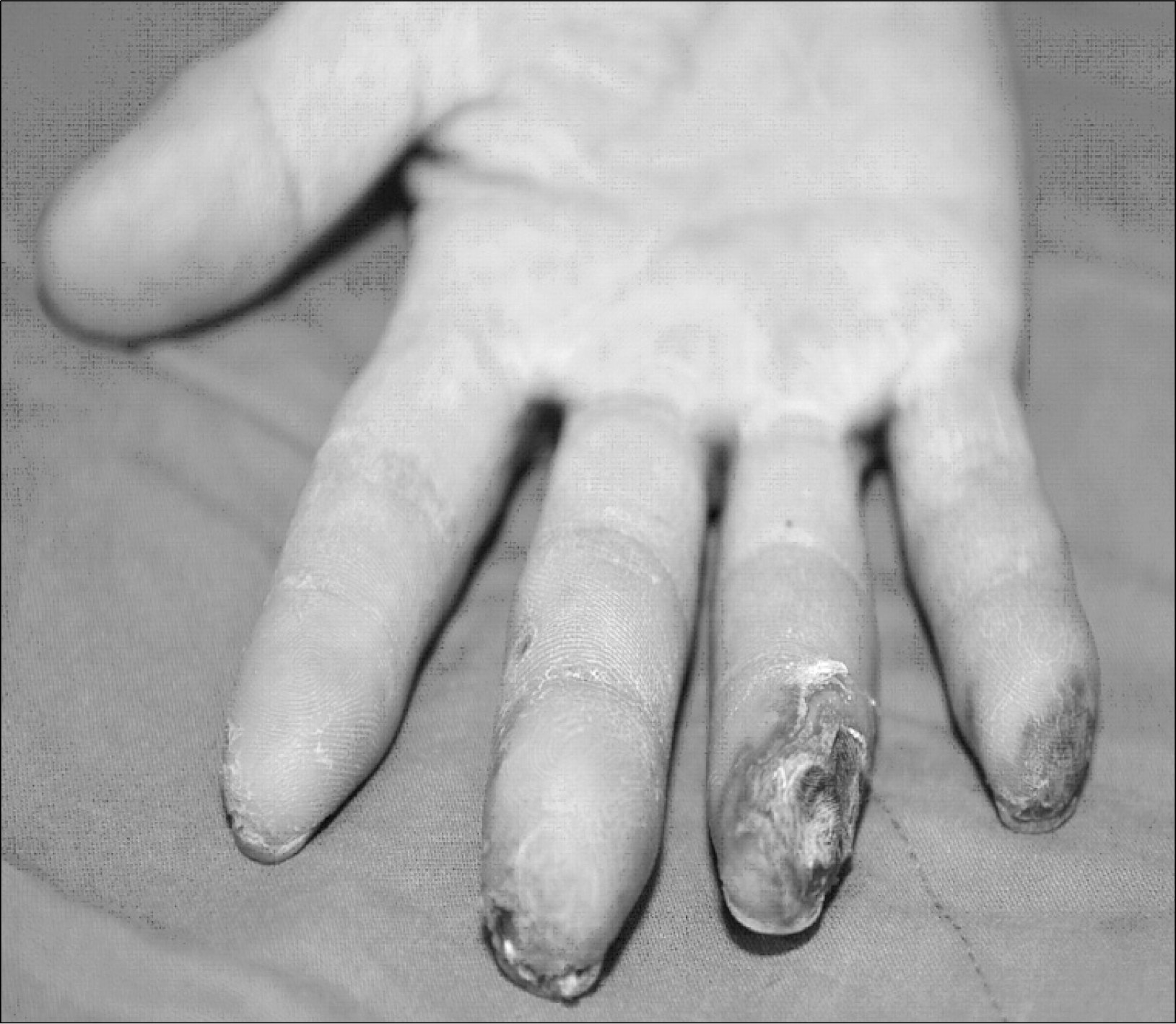Abstract
Hypothenar hammer syndrome (HHS) is a non-atherosclerotic, non-inflammatory vascular disease that causes a digital ischemia as a result of the occlusion of distal ulnar artery adjacent to the hook of hamate. This syndrome is usually observed in men who use the hypothenar eminence of the hand to grip devices such as a hammer. As a consequence of repeated blunt trauma, the ulnar artery beneath hypothenar eminence may lead to pathologic changes, such as intima-medial hyperplasia and reactive inflammatory infiltrates, which lead to the digital ischemia. We experienced a case of HHS with digital ulcerations which occurred after intensive work with nail remover for 10 days. Selective angiography of right forearm showed complete occlusion of the ulnar artery at the level of hook of hamate with deficient superficial palmar arch. After treatment with intravenous prostaglandin E1 and heparin, the ulcerative lesions of fingers improved without surgical intervention, which implicates that medical management of HHS should be considered prior to the surgical treatment.
REFERENCES
1). Ferris BL., Taylor LM Jr., Oyama K., McLafferty RB., Edwards JM., Moneta GL, et al. Hypothenar hammer syndrome: proposed etiology. J Vasc Surg. 2000. 31:104–13.

2). Stone JR. Intimal hyperplasia in the distal ulnar artery; influence of gender and implications for the hypothenar hammer syndrome. Cardiovasc Pathol. 2004. 13:20–5.
4). Spencer-Green G., Morgan GJ., Brown L., FitzGerald O. Hypothenar hammer syndrome: an occupational cause of Raynaud's phenomenon. J Rheumatol. 1987. 14:1048–51.
5). Lambert M., Hatron PY., Hachulla E., Devulder B. Hypothenar hammer syndrome followed by systemic sclerosis. J Rheumatol. 2000. 27:2516–7.
6). Liskutin J., Dorffner R., Resinger M., Silberbauer K., Mostbeck G. Hypothenar hammer syndrome. Eur Radiol. 2000. 10:542.

7). Higgins JP., Orlando GS., Chang P., Serletti JM. Hypothenar hammer syndrome after radial forearm flap harvest: a case report. J Hand Surg [Am]. 2001. 26:772–5.

8). Wong GB., Whetzel TP. Hypothenar hammer syndrome–review and case report. Vasc Surg. 2001. 35:163–6.
9). Birrer M., Baumgartner I. Images in clinical medicine. Work-related vascular injuries of the hand–hypothenar hammer syndrome. N Engl J Med. 2002. 347:339.
10). Taylor LM Jr. Hypothenar hammer syndrome. J Vasc Surg. 2003. 37:697.
11). Abudakka M., Pillai A., Al-Khaffaf H. Hypothenar hammer syndrome: rare or underdiagnosed? Eur J Vasc Endovasc Surg. 2006. 32:257–60.

12). Thompson A., House R. Hand-arm vibration syndrome with concomitant arterial thrombosis in the hands. Occup Med (Lond). 2006. 56:317–21.

13). Gellman H., Botte MJ., Shankwiler J., Gelberman RH. Arterial patterns of the deep and superficial palmar arches. Clin Orthop Relat Res. 2001. 41–6.

14). Aleksic M., Heckenkamp J., Gawenda M., Brunkwall J. Occupation-related vascular disorders of the upper extremity–two case reports. Angiology. 2006. 57:107–14.
Fig. 2.
Angiography of the right hand shows total occlusion of the ulnar artery at the level of hook of hamate (arrow-heads) and poor filling of superficial palmar arch (A), while that of the unaffected left hand shows normal filling of the ulnar artery, radial artery, superficial and deep palmar arch (B).

Table 1.
The clinical characteristics of the patients with hypothenar hammer syndrome and digital ulceration. We searched for original articles published between 1977 and 2007 using the search terms “hypothenar hammer syndrome” in MEDLINE




 PDF
PDF ePub
ePub Citation
Citation Print
Print



 XML Download
XML Download